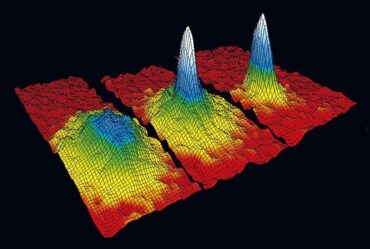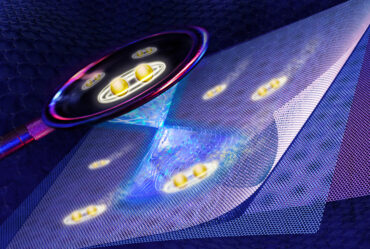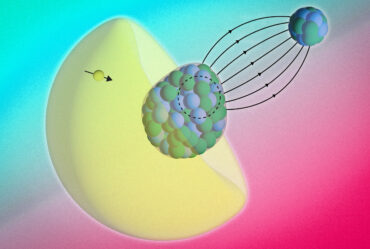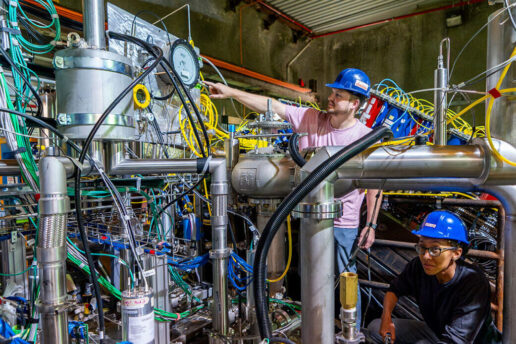
DUNE Scientists Observe First Neutrinos with Prototype Detector at Fermilab
DUNE’s prototype particle detection system, designed and built by a collaboration led by Berkeley Lab, has successfully recorded its first accelerator neutrinos.
Adapted from a news release by Fermi National Accelerator Laboratory.
In a major step for the international Deep Underground Neutrino Experiment (DUNE), scientists have detected the first neutrinos using a DUNE prototype particle detector at the U.S. Department of Energy’s Fermi National Accelerator Laboratory (Fermilab).
The revolutionary new technology at the heart of DUNE’s new prototype detector is LArPix, an innovative end-to-end pixelated sensor and electronics system capable of imaging neutrino events in true-3D that was conceived, designed, and built by a team of Lawrence Berkeley National Laboratory (Berkeley Lab) physicists and engineers and installed at Fermilab earlier this year.
DUNE, currently under construction, will be the most comprehensive neutrino experiment in the world. It will enable scientists to explore new areas of neutrino research and possibly address some of the biggest physics mysteries in the universe, including searching for the origin of matter and learning more about supernovae and black hole formation.
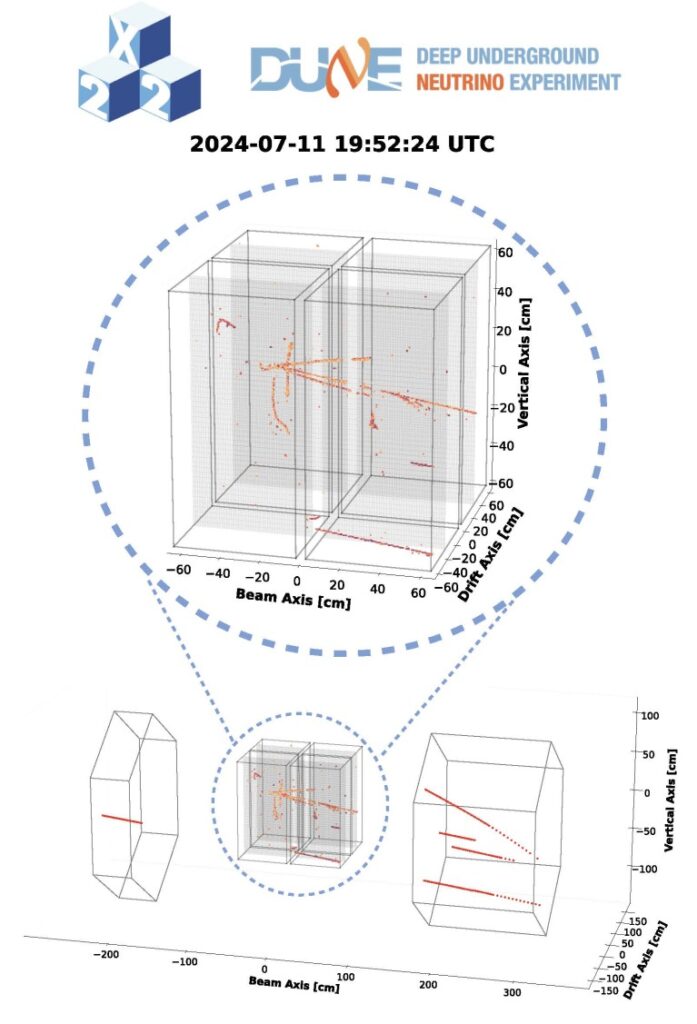
Since DUNE will feature new designs and technology, scientists are testing prototype equipment and components in preparation for the final detector installation. In February, the DUNE team finished the installation of their latest prototype detector in the path of an existing neutrino beamline at Fermilab. On July 10, the team announced that they successfully recorded their first accelerator-produced neutrinos in the prototype detector, a step toward validating the design.
“This is a truly momentous milestone demonstrating the potential of this technology,” said Louise Suter, a Fermilab scientist who coordinated the module installation. “It is fantastic to see this validation of the hard work put into designing, building, and installing the detector.”
Berkeley Lab leads the engineering integration of the new neutrino detection system, part of DUNE’s near detector complex that will be built on the Fermilab site. Its prototype – known as the 2×2 prototype because it has four modules arranged in a square – records particle tracks with liquid-argon time projection chambers.
“DUNE needed a liquid-argon TPC (LArTPC) detector that could tolerate a high-intensity environment, but this was thought to be impossible,” said Dan Dwyer, the head of the Berkeley Lab’s Neutrino Physics Group and the project’s technical lead for the ND-LAr Consortium, which contributed key elements to the new system’s design and fabrication. “With the invention of LArPix, our team at LBNL has made this dream a reality. The 2×2 Demonstrator now installed at DUNE combines our true-3D readout with high-coverage light detectors, producing a truly innovative particle detector.”
Brooke Russell, formerly a Chamberlain Postdoctoral Fellow at Berkeley Lab and now the Neil and Jane Pappalardo Special Fellow in Physics at MIT, played a crucial role in the development of the 2×2 prototype, which she describes as “a first-of-its-kind detector, with more than 337,000 individual charge-sensitive pixels at roughly 4-millimeter granularity.” Berkeley Lab led the design, construction, and testing of the end-to-end pixelated charge readout system during the COVID-19 pandemic.
“Operation of the 2×2 prototype in a neutrino beam will usher in a new era of high-fidelity, inherently 3D LArTPC images for neutrino interaction measurements,” Russell said.
The final version of the DUNE near detector will feature 35 liquid argon modules, each larger than those in the prototype. The modules will help navigate the enormous flux of neutrinos expected at the near site.
The 2×2 prototype implements novel technologies that enable a new regime of detailed, cutting-edge neutrino imaging to handle the unique conditions in DUNE. It has a millimeter-sized pixel readout system, developed by a team at Berkeley Lab, that allows for high-precision 3D imaging on a large scale. This, coupled with its modular design, sets the prototype apart from previous neutrino detectors like ICARUS and MicroBooNE.
Now, the 2×2 prototype provides the first accelerator-neutrino data to be analyzed and published by the DUNE collaboration.
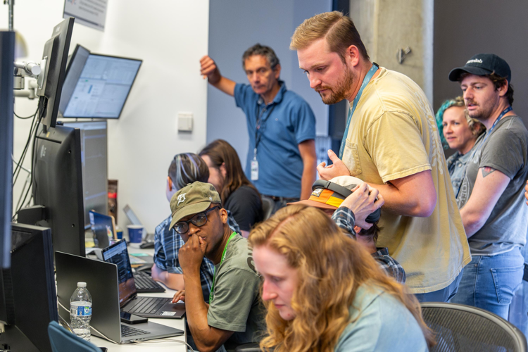
DUNE is split between two locations hundreds of miles apart: A beam of neutrinos originating at Fermilab, close to Chicago, will pass through a particle detector located on the Fermilab site, then travel 800 miles through the ground to several huge detectors at the Sanford Underground Research Facility (SURF) in South Dakota.
The DUNE detector at Fermilab will analyze the neutrino beam close to its origin, where the beam is extremely intense. Collaborators expect this near detector to record about 50 interactions per pulse, which will come every second, amounting to hundreds of millions of neutrino detections over DUNE’s many expected years of operation. Scientists will also use DUNE to study neutrinos’ antimatter counterpart, antineutrinos.
This unprecedented flux of accelerator-made neutrinos and antineutrinos will enable DUNE’s ambitious science goals. Physicists will study the particles with DUNE’s near and far detectors to learn more about how they change type as they travel, a phenomenon known as neutrino oscillation. By looking for differences between neutrino oscillations and antineutrino oscillations, physicists will seek evidence for a broken symmetry known as CP violation to determine whether neutrinos might be responsible for the prevalence of matter in our universe.
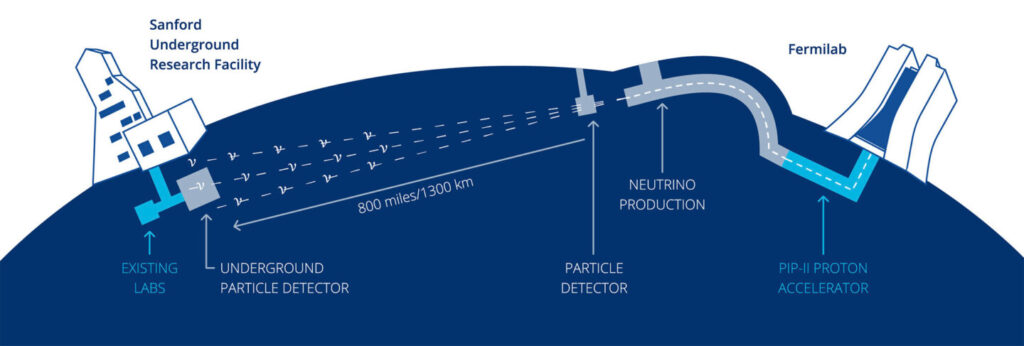
The DUNE collaboration is made up of more than 1,400 scientists and engineers from over 200 research institutions. Nearly 40 of these institutions work on the near detector. Specifically, the hardware development of the 2×2 prototype was led by the University of Bern in Switzerland, DOE’s Fermilab, Berkeley Lab, and SLAC National Accelerator Laboratory, with significant contributions from many universities.
“The 2×2 Demonstrator has been a real labor of love,” said Dwyer. “It started with a few dedicated teams who saw the potential for these novel technologies to come together as an exceptional particle detector. Now that the project is moving forward, the results are very impressive and these spectacular images from the 2×2 Demonstrator prove that we were on the right track.”
“It is wonderful to see the success of the technology we developed to measure neutrinos in such a high-intensity beam,” said Michele Weber, a professor at the University of Bern – where the concept of the modular design was born and where the four modules were assembled and tested – who leads the effort behind the new particle detection system. “A successful demonstration of this technology’s ability to record multiple neutrino interactions simultaneously will pave the way for the construction of the DUNE liquid argon near detector.”
Next steps
Testing the 2×2 prototype is necessary to demonstrate that the innovative design and technology are effective on a large scale to meet the near detector’s requirements. A modular liquid-argon detector capable of detecting high rates of neutrinos and antineutrinos had never been built or tested before.
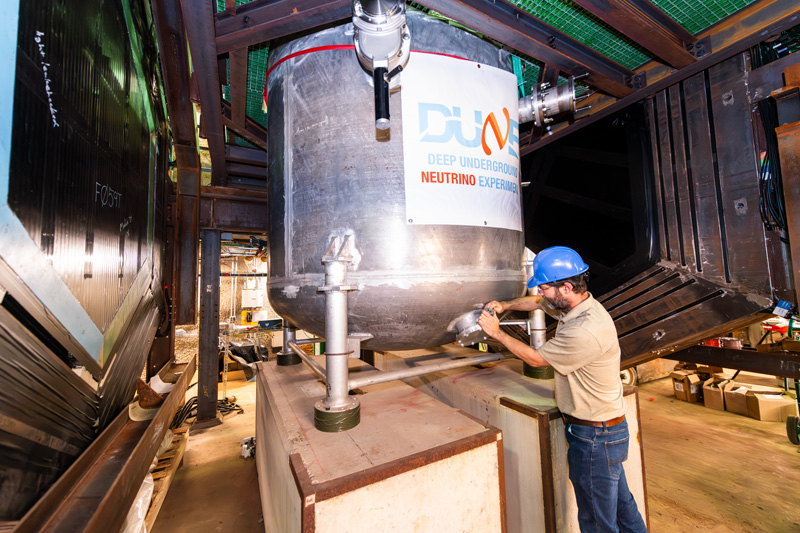
The existing Fermilab beamline is an ideal place for testing and presents an exciting opportunity for researchers to measure these mysterious particles. It is currently running in “antineutrino mode,” so DUNE scientists will use the 2×2 prototype to study the interactions between antineutrinos and argon. When antineutrinos hit argon atoms, as they will in the argon-filled near detector, they interact and produce other particles. The prototype will observe what kinds of particles are produced and how often. Studying these antineutrino interactions will prepare scientists to compare neutrino and antineutrino oscillations with DUNE.
“Analyzing this data is a great opportunity for our early-career scientists to gain experience,” said Kevin Wood, the first run coordinator for the 2×2 prototype and a Chamberlain Postdoctoral Fellow at Berkeley Lab, where the prototype’s novel readout system was developed. “The neutrino interactions imaged by the 2×2 prototype will provide a highly anticipated dataset for our graduate students, postdocs, and other young collaborators to analyze as we continue to prepare to bring DUNE online.”
The DUNE collaboration plans to bombard the 2×2 prototype with neutrinos from the Fermilab beam for several months.
Sergio Bertolucci, professor of physics at the University of Bologna in Italy and co-spokesperson of DUNE with Mary Bishai of Brookhaven National Laboratory, said, “This is an exciting milestone for the 2×2 team and the entire DUNE collaboration. Let this be the first of many neutrino interactions for DUNE!”
###
Lawrence Berkeley National Laboratory (Berkeley Lab) is committed to delivering solutions for humankind through research in clean energy, a healthy planet, and discovery science. Founded in 1931 on the belief that the biggest problems are best addressed by teams, Berkeley Lab and its scientists have been recognized with 16 Nobel Prizes. Researchers from around the world rely on the lab’s world-class scientific facilities for their own pioneering research. Berkeley Lab is a multiprogram national laboratory managed by the University of California for the U.S. Department of Energy’s Office of Science.
DOE’s Office of Science is the single largest supporter of basic research in the physical sciences in the United States, and is working to address some of the most pressing challenges of our time. For more information, please visit energy.gov/science.
